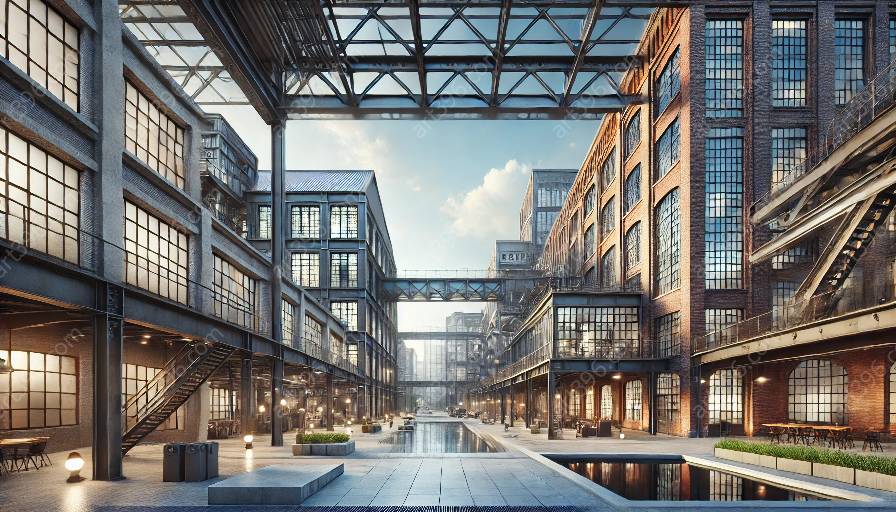Industrial architecture plays a crucial role in shaping the urban landscape, but it also presents various challenges when it comes to integration. The process of integrating industrial architecture with urban landscapes involves considerations of function, aesthetics, and the overall impact on the built environment. This article explores the complexities and challenges associated with this integration, offering insights into the balance between industrial functionality and urban harmony.
The Role of Industrial Architecture in Urban Landscapes
Industrial architecture encompasses the design and construction of buildings and structures used for industrial purposes, such as manufacturing, production, and distribution. These facilities are often characterized by their utilitarian and functional design, featuring large-scale infrastructure, industrial machinery, and a focus on operational efficiency. In urban landscapes, industrial architecture forms an integral part of the built environment, contributing to the economic and industrial fabric of cities and towns.
When integrated thoughtfully, industrial architecture can add a distinct character to urban areas, reflecting the industrial heritage and identity of a city. The juxtaposition of industrial structures against the backdrop of urban life creates a unique visual and spatial dynamic, showcasing the coexistence of industrial activity within the urban fabric. However, the integration of industrial architecture with urban landscapes presents significant challenges that need to be carefully addressed to ensure a cohesive and balanced environment.
Challenges and Considerations
Integrating industrial architecture with urban landscapes requires a comprehensive understanding of the challenges and considerations involved in harmonizing these two distinct elements. Some of the key challenges include:
- Visual Compatibility: Industrial architecture often features stark, utilitarian aesthetics that can contrast with the traditional architectural styles and design elements found in urban settings. Finding a visual balance that preserves the industrial character while complementing the urban context is essential for successful integration.
- Zoning and Land Use: Industrial facilities may require specific zoning designations and land use permissions, which can impact their placement within urban areas. Balancing the need for industrial infrastructure with the overall land use planning and urban development goals presents a significant challenge.
- Urban Regeneration: Introducing industrial architecture into urban landscapes often involves repurposing or adapting existing industrial structures. Urban regeneration projects require careful planning to transform outdated industrial sites into vibrant, sustainable urban spaces while preserving their historical and architectural significance.
- Environmental Impact: Industrial facilities can have significant environmental footprints, including considerations related to noise, air quality, and resource consumption. Mitigating the environmental impact of industrial architecture within urban areas is crucial for promoting sustainability and minimizing disruptions to the urban ecosystem.
- Public Perception: The integration of industrial architecture with urban landscapes can influence public perception and community acceptance. Balancing the functional needs of industrial facilities with the desires and concerns of local residents and stakeholders requires effective community engagement and transparent communication.
Strategies for Successful Integration
Despite the challenges, successful integration of industrial architecture with urban landscapes is achievable through strategic planning and design interventions. Some strategies to consider include:
- Adaptive Reuse: Repurposing existing industrial structures for new functions, such as converting old warehouses into mixed-use developments or creative workspaces, can breathe new life into industrial sites while preserving their architectural heritage.
- Architectural Synergy: Exploring design approaches that blend industrial aesthetics with contemporary urban architecture can create a harmonious visual language, maintaining the industrial identity while aligning with the surrounding built environment.
- Sustainable Practices: Integrating sustainable design principles and green technologies into industrial architecture can minimize environmental impact and enhance the overall sustainability of urban landscapes, promoting a more balanced coexistence.
- Community Engagement: Involving local communities in the planning and design process fosters a sense of ownership and understanding, allowing for collaborative solutions that address the needs of both industrial stakeholders and urban residents.
- Regulatory Adaptation: Rethinking zoning regulations and land use policies to accommodate the evolving relationship between industrial architecture and urban landscapes can facilitate a more flexible and responsive approach to integration.
Conclusion
Integrating industrial architecture with urban landscapes presents a multifaceted challenge that requires a careful balance of functional, aesthetic, and environmental considerations. By recognizing the complexities involved and embracing innovative strategies, cities can create cohesive and dynamic urban environments that celebrate the coexistence of industrial heritage and contemporary urban life. Addressing these challenges with creativity and foresight paves the way for a more integrated and harmonious built environment that reflects the evolving needs of both industry and urban communities.





























































